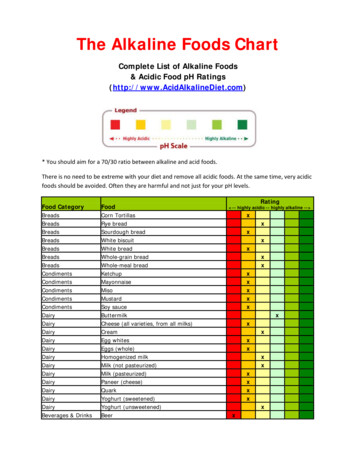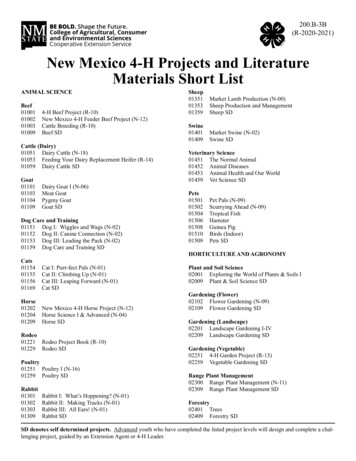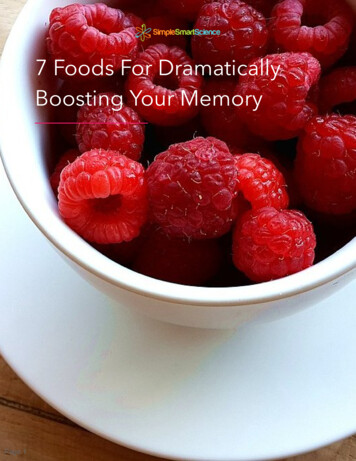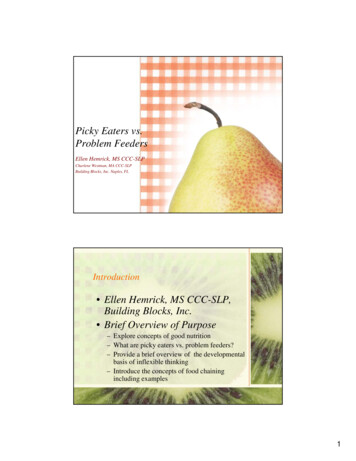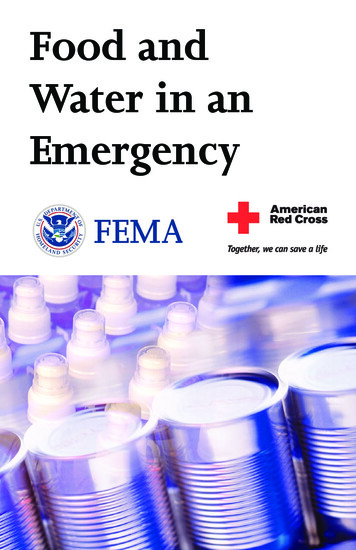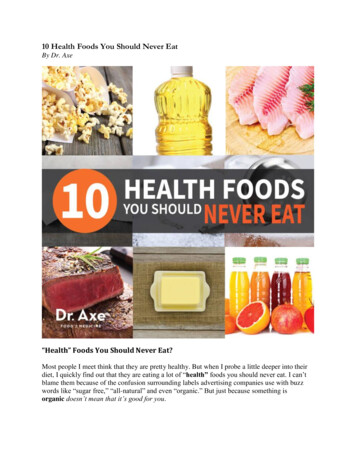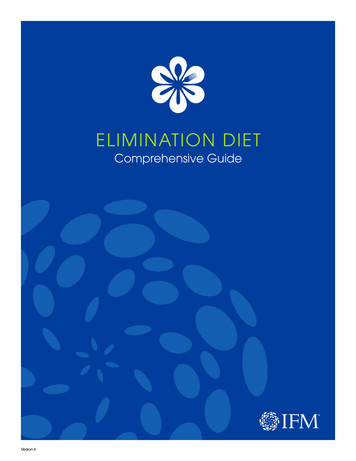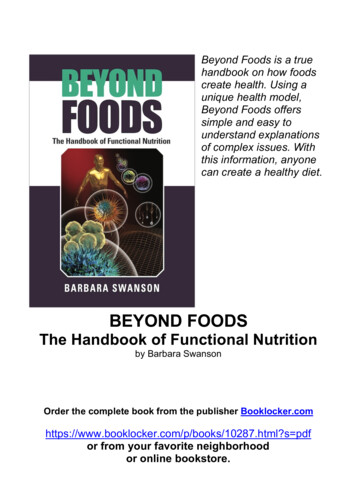
Transcription
Beyond Foods is a truehandbook on how foodscreate health. Using aunique health model,Beyond Foods offerssimple and easy tounderstand explanationsof complex issues. Withthis information, anyonecan create a healthy diet.BEYOND FOODSThe Handbook of Functional Nutritionby Barbara SwansonOrder the complete book from the publisher 0287.html?s pdfor from your favorite neighborhoodor online bookstore.
Copyright 2019 Barbara SwansonISBN: 978-1-64438-643-9All rights reserved. No part of this publication may bereproduced, stored in a retrieval system, or transmitted in anyform or by any means, electronic, mechanical, recording orotherwise, without the prior written permission of the author.Published by BookLocker.com, Inc., St. Petersburg, Florida.Graphic Illustrations with Julie WinsbergBarbara Swanson retains sole copyright to the information andillustrations in this book. No part of this book may be reproducedby any mechanical, photographic or electronic process. It maynot be stored in any retrieval system, translated or copied forpublic or private use, other than brief passages quoted forpurposes of review, without express permission from the author.Library of Congress Cataloging in Publication DataSwanson, BarbaraBeyond Foods The Handbook of Functional Nutrition by BarbaraSwansonHEALTH & FITNESS / Diet & Nutrition / General HEALTH & FITNESS /Diet & Nutrition / Nutrition HEALTH & FITNESS / Healthy LivingLibrary of Congress Control Number: 2019902472Printed on acid-free paper.Booklocker.com, Inc.2019
ACKNOWLEDGEMENTSI have more people to thank than is possible to list.However, I wish to publicly acknowledge those withoutwhom this book would not exist.First and foremost, I wish to thank Donia Al’Alawi. This bookcould not exist without her input including ideas, years ofcollaboration, inspiration and insight on the resolution ofhow to, as best as possible, communicate in a simple waysome of the very complex ideas involved in how functionalnutrition works.I also wish to thank the entire field of business peers withwhom I work. There are hundreds of you and while I don'thave room to list your names--1 could. You are allimportant.Of special note are my friends and much more—you knowwho you are. I wish to thank my mentor in understandingthe deep history of foods, Steve Gagne; the Father of LivingFoods and dear friend, Viktoras Kulvinskas; Katharine Clark,a living avatar of the Live Foods movement; and fellowauthor (and one who is far more accomplished than I), Dr.Jeffrey Bruno, whose research on Earth's most ancient foodwill enlighten our world.And most of all: deep love and gratitude for my children,who have supported me no matter what path I havewalked.
DISCLAIMERThis book details the author's personal experiences with andopinions about health and diet. The author is not a healthcareprovider. All names used in this book have been changed toprotect my clients.The statements in this book have not been evaluated by the U.S.Food and Drug Administration. They are not intended todiagnose, treat, cure, or prevent any condition or disease. Pleaseconsult with your own physician or healthcare specialistregarding the suggestions and recommendations made in thisbook.This book is not intended as a substitute for consultation with alicensed healthcare practitioner, such as your physician. Beforeyou begin any healthcare program, consult your physician orother licensed healthcare practitioner to ensure that you are ingood health and that the examples contained in this book willnot harm you.
Beyond FoodsThe Handbook of Functional NutritionFOREWORD. xiWHY DIETS DON"T WORK . xiiiSECTION 1 - What Happened to Our Food? . 1Chapter 1 - The History of Food . 3NATURALWASHING AND GREENWASHING . 8FUNCTIONAL NUTRITION . 12Chapter 2 - Food Vs. Fake. 14WHY WON"T JUNK FOODS NOURISH ME? . 14NANO-TECH NUTRIENTS . 16FOOD AS MEDICINE . 17MEDICINE VS NATURAL HEALING . 19Chapter 3 - Three Secrets of a Healthy Diet. 21SECTION 2 - The 4 Building Blocks of Functional Nutrition . 31Chapter 4 - Your Complex Body Made Simple . 32BEYOND FOODS. 32Chapter 5 - Building Block 1: Superfoods The Raw Materialsof Cellular Health . 37WHY SUPERFOODS?. 38ESSENTIAL NUTRIENTS: VITAMINS . 39ESSENTIAL NUTRIENTS: MINERALS . 41ESSENTIAL NUTRIENTS: AMINO ACIDS . 46ESSENTIAL NUTRIENTS: ESSENTIAL FATTY ACIDS . 49ESSENTIAL NUTRIENTS: OTHER IMPORTANT PHYTONUTRIENTS . 52SUMMARY . 56WHAT YOU CAN DO . 57Chapter 6 - Building Block 2: Digestive Nutrients for Energy . 62DIGESTIVE NUTRIENTS IN HISTORY . 63ENZYMES . 64DIGESTIVE NEEDS. 66PLANT BASED DIGESTIVE ENZYMES . 69ENZYME SUPPLEMENT BENEFITS . 70PROBIOTIC BACTERIA . 73THE GUT AND YOUR BRAIN . 76vii
Beyond FoodsYOUR GUT AND IMMUNE FUNCTION . 77HOW PROBIOTICS WORK . 80ACIDOPHILUS . 80BlFlDUS. 82SUMMARY . 82WHAT YOU CAN DO . 83Chapter 7 - Building Block 3: Antioxidants to ProtectCellular Function . 85REACTIVE OXYGEN SPECIES . 85THE THEORY OF OXIDATIVE STRESS . 89ANTIOXIDANTS . 90NUTRIENT ANTIOXIDANTS . 92THE IMMUNE CONNECTION . 94SUMMARY . 95WHAT YOU CAN DO . 96Chapter 8 - Building Block 4: Regenerative Nutrients for HealthyRenewal . 98EPIGENETICS . 99PROMOTERS . 100TELOMERES and TELOMERASE . 102NUCLEIC ACIDS & DNA HEALTH . 103ADULT STEM CELLS . 104TESTIMONIAL # 4: Natalie’s story . 106SUMMARY . 107WHAT YOU CAN DO . 108CONCLUSION . 11110 EMPOWERING HEALTH FACTS . 112EMPOWERING NUTRITION TIPS . 114BIBLIOGRAPHY . 117viii
FOREWORD"Just imagine, how much easier our lives would be if we were bornwith a 'user guide or owner's manual' which could tell us what to eatand how to live healthy." Erika M. SzaboThis book is just that—an easy-to-understand hand book ofwhat your diet must contain for a healthy body. You won'tneed a degree to understand this information, nor will yoube asked to completely change your life and diet(although I am sure there are shifts you may wish to makeafter reading this). Knowledge is power!Over the last 25 years of working as a health consultant, myfocus has always been to help people achieve a greaterlevel of physical, mental and emotional wellbeing throughlifestyle choices, with an emphasis on the benefits of whole,ancient foods and food-based supplements. I see, nearlyon a daily basis, the struggle people have trying to makethe best, most affordable and simplest choices for theirhealth needs.I am fortunate to have been taught by a wide variety ofmentors and icons in the alternative health and nutritionfield. This wide lens view kept me from thinking there is onlyone “right way” to eat for health.I have had the privilege of learning directly from ViktorasKulvinskas, co-founder of the Hippocrates Health Institute,author of the health classic, Survival in the 21st Century, andfather of the Living Foods movement. I have worked closelywith several teachers from the renowned Kushi Institute,home of the modern Macrobiotic movement.xi
Beyond FoodsI routinely consult with athletes and trainers who expoundthe Paleo diet; those who are vegans or vegetarian; andpeople who eat fast food weekly and are hoping for achange.Through the process of doing hundreds of personalconsultations, I have seen the great need people have fora basic nutritional education to help them understand howto determine if a diet change or supplement would bebeneficial—or not.Over the space of a 12 year (and counting) researchjourney, I read books about nutritional science and studieddifferent nutritional and lifestyle alternatives to Westernmedicine. Information was gathered from other researcherson specific health topics, such as digestive health,enzymatic nutrition, and how specific nutrients affectvarious organs and systems. I learned how light is turned intothe food we eat and about Food Energetics.Hundreds of human clinical trials, epidemiological studies, invivo and in vitro studies, and many double blind peerreviewed scientific studies were reviewed.After thousands of hours of research, I came to realize thatthere is an underlying order to how foods and supplementswork to create better health. This knowledge helps explainthe powerful benefits of using whole, wild foods as anessential component of a healthy diet.xii
The Handbook of Functional NutritionWHY DIETS DON"T WORKThe usual thread in “going on a diet” is that each tries tooffer a single, simple solution to a specific problem—i.e.,how to lose weight, have more energy, cleanse toxins orcreate more muscle mass. Each need is approached as aseparate issue. People are taught to find “the diet” or “thesupplement” that will work for what they want at thatmoment.The truth is: Unless your diet fulfills the ongoing basic nutrientrequirements of all your cells and organ systems, you willlikely fail at meeting any long-term dietary goal.Diet is not a fad you use for a few weeks or months. A diet ishow you provide the nutrients and micronutrients thatsupport your body's physical needs right now—and nextyear, and in ten years. In fact, no matter what physicalstate you are in at the moment, no matter what yourspecific health situation, the nutritional factors you need forlife must be in the foods and supplements you eat.This book doesn't offer or recommend a specific diet, otherthan one that is filled with real, whole foods and whole foodsupplements, adding in wild and ancient foods as much aspossible.This book is the distilled result of knowledge gleaned fromdozens of indigenous diets, backed by hundreds ofscientific studies from widely varying sources. It presents youwith a simple and complete system that helps youunderstand how to eat: The 4 Building Blocks of FunctionalNutrition.xiii
Beyond FoodsBeyond Foods offers a new way to look at both diet andsupplementation. You won’t read how to eat “to loseweight” or “lower inflammation” or “get rid of belly fat” as ifthey are separate problems.Realize this—you don't need a supplement to lose weight;then another supplement to lower inflammation; and yet adifferent program to detox and cleanse. You need to eat adiet and use powerful whole-food based supplements filledwith the whole food nutrients that support cellular healthand body systems. Your body will then do the rest of thework to retain health to the best of your genetic capacity.And science has shown that even your own genetic codecan be rewritten, to some degree, via a healthy diet andlifestyle choices.My goal is to make sure that you know what your bodyneeds on the cellular level—regardless of the type of dietyou choose. I want to help you choose supplements thatare not a waste of money, or worse, actually cause anutritional imbalance.Once you understand what you need in your diet—andwhy—you can make informed choices that will give you thebenefits you need.You will learn what to eat in order to allow the innateintelligence of your genetics to work to their fullestpotential You will learn how to eat Beyond Foods.Barbara Swansonxiv
SECTION 1What Happened to Our Food?It should be simple. Make a grocery list, buy the food, makea meal--and be nourished.Not so long ago that was true.Today, however, we really do live in a different world--- andour eating choices have to be more conscious if we are toactually be nourished with what we eat.1
Chapter 1The History of FoodFor over 5000 years humans have used foods to prevent orease the symptoms of various diseases. (The old adage “Anapple a day keeps the doctor away” has recently beenscientifically validated.)The truth is that modern medicine has a history of poohpoohing “old wives' tales”, only to then discover they arebased on verifiable scientific facts. This attitude is ironic,considering that using foods as the first choice to heal orprevent diseases was laid out by the father of modernmedicine, Hippocrates, over 2000 years ago.In the modern world, it is important to find a great wholefoods micronutrient support program. Sadly, most peopletoday eat a diet filled with “foods” that do not—cannot—actually nourish them.Even seventy-five years ago, you didn't really need to thinkabout what you ate—or even to know how or what foodsnourished your body. If you ate it, you would be nourished.Until the mid-20th century, the majority of foods eaten on adaily basis were home-grown or locally sourced. Seventyfive years ago, the foods we ate were raised without anoverload of herbicides or pesticides. There were noconcerns with GMO contamination.Milk wasn't homogenized for shelf life then pasteurized toprotect us from the results of cattle being raised inunhealthy conditions. Cattle weren't fed antibiotics,3
Beyond Foodshormones and steroids to increase productivity. Shippingfrom massive farming complexes and using chemicalfertilizers, herbicides and pesticides was not the norm untilthe fifties.After WWII we experienced another dramatic downwardshift in nourishment from our daily foods: the proliferation ofconvenience foods, fast foods, and foods shipped fromaround the world, rather than sourced locally.Our diets moved away from freshly harvested, freshlyprepared whole foods into convenience and fast foods.Today the average fast food meal has about 80 syntheticadditives to enhance flavor and texture. Any single one ofthese additives could cause slight changes in brainchemistry. Added up together, they can spell disaster forhealthy brain function, especially in young, still developingbrains.yet doctors wonder about the increase in autisticand hyperactive behavior and can find no “cause”.We now eat far more processed foods and synthetics thanhave been determined to be safe. I—and many healtheducators and health professionals—believe the effects wedeal with include dramatic increases in chronic diseasesand a lowering of our standard of health at younger andyounger ages. We see upward climbs in profound braindysfunction and other diseases at early ages. ADD/ADHD,ASD (autistic spectrum disorder), juvenile diabetes andasthma are just the tip of the visible health dysfunctionsincreasing in our children.And it's not only foods we have to worry about. There areincreasing numbers of lab-created “nutrients” and syntheticsupplements. They seem to offer everything you need.4
The Handbook of Functional NutritionBut synthetic nutrients, isolated amino acids, processedfatty acids, minerals from rock, or any type of geneticallymodified (GMO) foods don't—can’t—offer wholesomenutrition.The reason for this is simple: We don’t assimilate them. Ourbodies cannot easily utilize isolated nutrients—and some,the body won't assimilate at all, or even recognize as food.In the last decade, people have woken up to the problemof finding actual, real, healthy nutrition in the foods theyeat. This has spurred a huge increase in sales of natural,green and organic foods and supplements. Sales ofsupplements is in the billions, as are sales of organic foods—and both categories have been growing yearly for over adecade. This isn’t a trend—it is a movement. As such,manufacturers want in on the sales action; even if whatthey offer isn’t really all that healthy.There are trends within this movement towards healthierfoods and supplements. Often, these trends are a reactionto the problems caused by eating too much processed andfast foods. A scientific study will show a problem with salt, orfat—but rather than saying, “don’t eat processed and fastfoods”, the advice gets carried over into a single nutrient,which could be found in all foods. What all these trendshave in common is this: if people will pay for something, amanufacturer will sell and promote it.Often this leads to some manufacturer making a “safer,better” food—usually through replacing the nutritionalculprit with a different, processed ingredient, which oftenwinds up being far worse for your health. Let’s look at a fewexamples.5
Beyond FoodsOne of the first trends was to limit salt. And indeed, highlevels of regular table salt are deadly! However, rather thaneducation on the need for drinking healthy amounts ofgood water, Americans were advised to simply eat lowsodium diets. Sodium continues to be a concern for many,mostly because most processed foods and restaurant chainmeals contain obscene amounts of salt as a cheap flavorenhancer for low quality ingredients. Salt substitutes cameinto being, but Information and understanding about theneed for healthy salt is not very available, and informationon the dangers of salt substitutes is hard to find.FAST FIX: If you use boxed or canned foods, or go to fastfood restaurants weekly, begin by replacing a single meal aweek with whole foods—i.e. vegetables, fruits, whole grains,beans and rice you purchase and cook yourself. Useflavoring spices to replace salt. Spices like paprika andmustard work with nearly any meal. Add garlic and otheraromatics to add flavor. You will be in control of the salt youadd. Use a natural, unheated salt such as Celtic Gray anddiscover just how little salt is needed to add great flavor.Next came the trend to limit fats. And like no salt/low salt,people are still looking for a “low fat/no fat” number ontheir food—and too often pay next to no attention to anyother information on the label—such as synthetic additivesto add flavor. Manufacturers have created chemicals thatwill prevent fat absorption—which are now found to lead tovitamin deficiencies and other severe digestive problems.Only this year has the government stepped in to actuallylimit sales of trans-fats—processed fats which are known tolead to chronic inflammation, which is a root of hundreds ofdiseases and conditions. In recent years, the need forhealthy fats has spurred people to add “good” fats back invia adding omega fatty acid supplements.6
The Handbook of Functional NutritionFAST FIX: Eat real foods with good fats in moderateamounts. Half of a raw avocado or a small handful of seedsand nuts are fantastic sources of healthy fats and give anamazing energy boost in the afternoon. Two teaspoons ofvirgin olive oil or virgin coconut butter has only 66 caloriesand adds a ton of flavor to a salad, cooked vegetables,popcorn or even granola.Refined sugar—and its real dangers—has been a problemfor decades. But in recent advertising campaigns, thedifferences between highly processed sugars and naturalfruit and other minimally processed sugar sources (such ashoney) are minimized and even outright denied. Instead oflimiting or eliminating soda and candy, people use DEADLYsynthetic substitutes, which are finally being proven to notonly be dangerous, but ineffective at helping controlweight loss.FAST FIX: Use 1-2 teaspoons of raw honey, real maple syrupand yacon syrup to flavor foods. Eat fresh raw fruits. Eat asnack with fiber if you want something sweet—fiber slowsthe absorption of sugar into your blood stream. If you cravejuice, make it raw and fresh—the cost will keep you fromdrinking more than is good for you and the fiber is healthy.We are now in the midst of a trend to remove all glutenfrom all foods. Many people believe they have celiacdisease, a very severe immune response to a protein foundin gluten, which is always in wheat and often in other grains.However, there is a fundamental and large differencebetween true celiac disease and gluten sensitivity. Ipersonally believe the dramatic increase in gluten reactionsis a byproduct of the fact that nearly all non-organic grainsare now GMO. GMO grains have protein sequences whichcan stimulate immune reactions just like celiac disease.7
Beyond FoodsBut an understanding of the issue of a GMO proteinintolerance and your body’s reactions mimicking glutensensitivity is barely acknowledged so people are payingdouble and triple the normal cost of an item for that“gluten-free” label.FAST FIX: Use all organic grains to minimize exposure toGMO wheat and other grains. See if this helps with grainsensitivity reactions. Instead of processed grain foods—pasta, breads, etc.—buy WHOLE gains, such as steel cutoats, quinoa and brown rice. NOTE: If you have true celiacdisease, you need to be 100% gluten free.NATURALWASHING AND GREENWASHINGGreenwashing is the term used to describe when amanufacturer uses meaningless terms and words coupledwith impressive marketing to give the impression theirproduct is environmentally safe and friendly, natural andgood for you—even if their product is known to be toxic.Examples of this are Coca-Cola using “plant-based” plasticin their new bottles, and Clorox purchasing Burt’s Bees tosweeten their corporate profile.Naturalwashing is the supplement equivalent ofgreenwashing. Words like “natural” and “plant-derived”sound encouraging—but they have no actual meaningwith regards to the safety or quality of the product.Examples of naturalwashing include:Natural: This word has no legal meaning when it comes tosupplements or personal care. Basically, if it is on our planet,we can claim it is “natural”. Example: Crystal LightTM, whichis mostly synthetic flavors and aspartame, is called natural.8
The Handbook of Functional NutritionPlant-derived: can mean just about anything, since plantsform the majority of edible products in one way or another.Example: petrochemicals are “plant-derived”.Contains no artificial (flavorings, ingredients, etc.): Since theword natural has no legal definition, the definition ofartificial is nearly as meaningless.blend (Proprietary protein blend, trademarkedvegetable blend, etc.): Trademarked or proprietary, blendsare a great way to hide the fact that the main ingredientwithin in that blend might be cheap filler. It works like this: USlabeling laws require that ingredients are listed in order,from largest amount to least—with the exception ofproprietary blends. All ingredients within a trademarked orproprietary blend are allowed to be listed in any order themanufacturer desires.Example: A powdered vegetable drink has only 1 organicsuperfood, and it represents the least amount in theformula. On a regular label, it would have to be the lastingredient on the label. However, if the manufacturercreates a proprietary blend, that lone organic superfoodcan now be listed first instead of last.Contains 100% RDA of Vitamins: Increasingly, supplementmanufacturers will add a few real food ingredients to mostlysynthetic products, in order to woo people who are lookingfor real food formulas. People see foods like blueberrypowder or kale and assume the list of synthetic vitamins thatfollows are from the foods listed. To my knowledge—and Ihave looked at hundreds of “food based” vitaminformulas—no 100% food formula will contain exactly100% ofall vitamins. If a drink blend is created from various driedfoods, they will not contain exactly100% of all vitamins. They9
Beyond Foodsmight contain MORE than 100% of a very few vitamins (suchas a drink with camu camu containing several hundredpercent of vitamin C’s RDA). When you see vitamins listed,followed by high percentages of the RDA, you can safelyassume the product is fortified with synthetic versions ofthose vitamins.Example: Legally, you can create a 100% synthetic vitaminformula, add it to a fermentation vat with a whole foodbase, and call your product “100% whole food vitaminformula”. There are at least 3 very popular whole foodvitamin formulas which do exactly this.Clinically proven: “Clinically proven” can meansomething or nothing at all. Consumers are aware thatmarketing and product promotional materials are filled withdeceitful statements. So they are cued in to look for somesort of scientific validation and the gold standard is ascientific study or clinical trial. I want to clarify that I am NOTsaying trials and studies are worthless—not at all. A peerreviewed double-blind placebo-controlled study or goodclinical trial can offer valuable insights into whether aproduct offers certain specific benefits. However both trialsand studies also have potential flaws with regards todetermining the value of food based supplements.1. Most studies focus on a single nutrient, and it is oftensynthetic. This allows the cause and results of thestudy to be easier to track and verify. However, wholefoods have multiple nutrients, working in concert.Therefore, the result of a study done on a singlenutrient may not reflect the entire range of benefitsfound in a whole food.2. Many studies on specific formulas or products aredone for a week or two, on a few people. This is a10
The Handbook of Functional Nutritioncheap way to get a “clinical trial” without anextreme cost.3. A clinical trial or scientific study is, by definition, anarrow snapshot of the whole. It can be extremelyvaluable to learn, for example, that a key nutrient isan anti-inflammatory. What is the outcome of this?Which is actually better for you—a product which ishighly processed to extract that single “proven”nutrient or the whole food which has that nutrientand HUNDREDS of others, which have not yet beenstudied?4. Clinical studies and trials are extremely expensive.There is a lot of private money to back most decentscientific studies or trials. Ask yourself, “Who makes themoney back?” The answer? Drug companies. Thedependence on this type of science as the only“good” science, with the dismissal of all other forms of“proof” as being irrelevant or “bad science” isdirectly correlated with the rise of drugs and drug useto replace foods as our primary way to handle healthand prevent disease. Foods are not easily quantifiedor qualified via the narrow parameters that areinherent in a study.Phony testimonials: People love to hear success stories—and companies know this. You can go from product toproduct online, and you will see that many of the personaltestimonials use EXACTLY the same wording, with only thename (first name only) changed. These are not real. Theseare lures, designed to hook you into trying a product whichmay not even be safe for you to use, much less good foryou.11
Beyond FoodsFUNCTIONAL NUTRITIONThis book is going to help you navigate through mine
This book doesn't offer or recommend a specific diet, other than one that is filled with real, whole foods and whole food supplements, adding in wild and ancient foods as much as possible. This book is the distilled result of knowledge gleaned from dozens of indigenous diets, backed by hu

